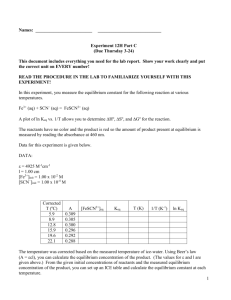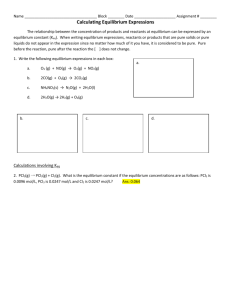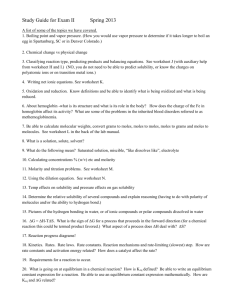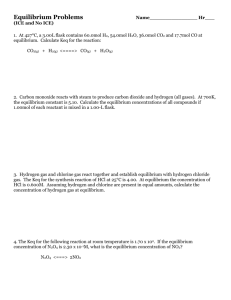Answers to equilibrium review (march 2012) 1. A reaction that goes
advertisement
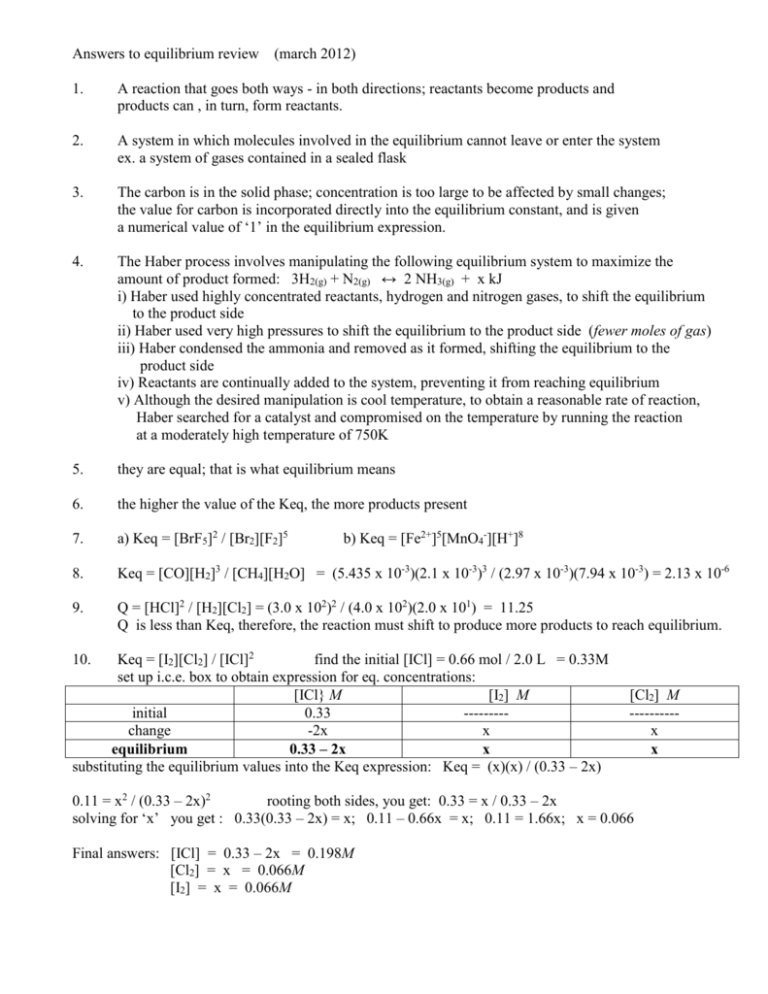
Answers to equilibrium review (march 2012) 1. A reaction that goes both ways - in both directions; reactants become products and products can , in turn, form reactants. 2. A system in which molecules involved in the equilibrium cannot leave or enter the system ex. a system of gases contained in a sealed flask 3. The carbon is in the solid phase; concentration is too large to be affected by small changes; the value for carbon is incorporated directly into the equilibrium constant, and is given a numerical value of ‘1’ in the equilibrium expression. 4. The Haber process involves manipulating the following equilibrium system to maximize the amount of product formed: 3H2(g) + N2(g) ↔ 2 NH3(g) + x kJ i) Haber used highly concentrated reactants, hydrogen and nitrogen gases, to shift the equilibrium to the product side ii) Haber used very high pressures to shift the equilibrium to the product side (fewer moles of gas) iii) Haber condensed the ammonia and removed as it formed, shifting the equilibrium to the product side iv) Reactants are continually added to the system, preventing it from reaching equilibrium v) Although the desired manipulation is cool temperature, to obtain a reasonable rate of reaction, Haber searched for a catalyst and compromised on the temperature by running the reaction at a moderately high temperature of 750K 5. they are equal; that is what equilibrium means 6. the higher the value of the Keq, the more products present 7. a) Keq = [BrF5]2 / [Br2][F2]5 8. Keq = [CO][H2]3 / [CH4][H2O] = (5.435 x 10-3)(2.1 x 10-3)3 / (2.97 x 10-3)(7.94 x 10-3) = 2.13 x 10-6 9. Q = [HCl]2 / [H2][Cl2] = (3.0 x 102)2 / (4.0 x 102)(2.0 x 101) = 11.25 Q is less than Keq, therefore, the reaction must shift to produce more products to reach equilibrium. b) Keq = [Fe2+]5[MnO4-][H+]8 Keq = [I2][Cl2] / [ICl]2 find the initial [ICl] = 0.66 mol / 2.0 L = 0.33M set up i.c.e. box to obtain expression for eq. concentrations: [ICl} M [I2] M initial 0.33 --------change -2x x equilibrium 0.33 – 2x x substituting the equilibrium values into the Keq expression: Keq = (x)(x) / (0.33 – 2x) 10. [Cl2] M ---------x x 0.11 = x2 / (0.33 – 2x)2 rooting both sides, you get: 0.33 = x / 0.33 – 2x solving for ‘x’ you get : 0.33(0.33 – 2x) = x; 0.11 – 0.66x = x; 0.11 = 1.66x; x = 0.066 Final answers: [ICl] = 0.33 – 2x = 0.198M [Cl2] = x = 0.066M [I2] = x = 0.066M 11. initial change equilibrium CH4 0.30 -x 0.30 - x CO2 0.40 -x 0.40 -x CO --------------------2x 0.40 H2 ---------------------2x 2x from the given data, we can see that 2x = 0.40; therefore, ‘x’, the change in equilibrium position, = 0.20 we can now determine the equilibrium concentrations of each gas: [CH4] = 0.10M; [CO2] = 0.20M; [CO] = 0.40M and [H2] = 0.40M we can now write the equilibrium expression, substitute, and determine Keq: Keq = (CO)2 (H2)2 / (CH4)(CO2) = (0.40)2(0.40)2 / (0.10)(0.20) = 1.28 12. a) Keq = [Cd2+][I-]4 / [CdI42-] initial change equilibrium CdI420.100 -x 0.100 -x Cd2+ ------------------------+x 0.013 I------------------------+4x 4x from the given data, we can see that x = 0.013; therefore, we can find the equilibrium concentrations of all three ions and calculate the Keq constant: at equilibrium: [CdI42-] = 0.100 - 0.013 = 0.087M [Cd2+] = 0.013M [I-] = 4(0.013) = 0.052M Keq = (0.013)(0.052)4 / (0.087) = 1.09 x 10-6 b) if the products increase when temperature is increased, the energy term must be on the left side, therefore the reaction is endothermic: x kJ + CdI42- Cd2+ + 4I- 13. (a) TlOH(s) → Tl+(aq) + OH-(aq) (b) Ag2CO3(s) → 2 Ag+(aq) + CO32-(aq) (c) Li3PO4(s) → 3 Li+(aq) + PO43-(aq) 14. Ksp = [Pb2+][C2O42-] 4.10 x 10-7 = s2 6.4 x 10-4 mol L-1 = s Ksp = [Tl+][OH-] Ksp = [Ag+]2[CO32-] Ksp = [Li+]3[PO43-] let ‘s’ = solubility of PbC2O4 in mol L-1 then [Pb2+] = s and [C2O42-] = s 15. Al(OH)3(s) Al3+(aq) + 3 OH-(aq) Ksp = [Al3+][OH-]3 Let ‘s’ = solubility of Al(OH)3 in water at 298K in mol/L Then, ‘s’ = [Al3+] and ‘3s’ = [OH-] 4.6 x 10-33 = (s)(3s)3 = 27s4 1.7 x 10-34 = s4 3.6 x 10-9 mol/L = s In g/L = (3.6 x 10-9 mol / 1 L)(78.01 g / 1 mol ) = 2.81 x 10-7 g / L 16. potential precipitate is AgCl AgCl(s) [Ag+][Cl-] Ksp = [Ag+][Cl-] [Ag+] after mixing is: (2.0 x 10-3M)(100.00 ml / 400.00 ml) = 5.0 x 10-4 M [Cl-] after mixing is: (6.00 x 10-3M)(300.00 ml / 400.00 ml) = 4.5 x 10-3 M Qsp = (5.0 x 10-4)(4.5 x 10-3) = 2.25 x 10-6 since Qsp < Ksp, no precipitate forms 17. The solubility equilibrium for PbCl2 is PbCl2(s) Pb2+(aq) + 2 Cl-(aq) When attempting to dissolve this solid in a saline solution, NaCl(aq), there is already lots of chloride ion present: PbCl2(s) Pb2+(aq) + 2 Cl-(aq) this forces the equilibrium to shift to the left, reducing the solubility. Multiple choice questions: 1. The value of the Keq constant is dependent on temperature; if temperature changes, the Keq also changes. choice B 2. choice A. the reaction is in dynamic equilibrium; both reactions occur at the same rate so there is no observable change in properties 3. no question #3 on review 4. choice B; an increase in a reactant shifts the equilibrium to the product side; there will be less of the reactant Cl2 5. choice D; is a reversible reaction in a closed system; choices A and C are not closed systems, and choice B is not in equilibrium 6. choice B: [N2] [H2] [NH3] initial 0.96M 0.72M ---------------change -x -3x 2x equilibrium 0.96 –x 0.72 – 3x 0.24 if 2x = 0.24, then ‘x’ = 0.12 and, at equilibrium [N2] = 0.84M and [H2] = 0.36M Keq = (0.24)2 / (0.84)(0.36)3 = 1.5 7. 8. choice D is the correct expression Keq = (0.225)2(0.110)2 / (0.65)2(0.400)3 choice A is correct = 0.023 9. initial change equilibrium H2 S 0.350M -2x O2 H2O 0.400M ------3x +2x 0.0600M SO2 --------+2x 0.0600M given that ‘2x’ = 0.0600M; then ‘x’ = 0.0300 and [O2] must be 0.400 – 3(0.0300) = 0.31M choice D is correct 10. choice C; the higher the Keq value, the more products at equilibrium 11. choice D; in row IV, if the volume is decreased, the reaction will shift to form fewer moles, which would be to the right, not the left as stated in the table. 12. choice A; this reaction has an equal number of moles of gas on both sides of the equation; volume changes will have no effect 13. choice B; increase in temperature shifts to products as reaction is endothermic; increase in volume also shifts to products, as there are 2 moles of gas on product side and only 1 mole of gas on reactant side. 14. choice E; since there are no products to start with, and the reaction produces 2 moles of CO2 for every 2 moles of H2O, these two gases must be equal at equilibrium; since 3 moles of oxygen are required to react with one mole of C2H4 and we are starting with equal numbers of moles, then there must be less O2 at equilibrium. since we do not know the value of the Keq, we cannot say where the equilibrium position will lie in statement III 15. choice A; since some oxygen gas was added, the equilibrium position will shift to the left, causing a loss of some of the NO gas, and an increase in the NO2 gas 16. since the reaction is exothermic, cooling the temperature will force the reaction to create more products; only temperature changes can change the value of the Keq constant.



